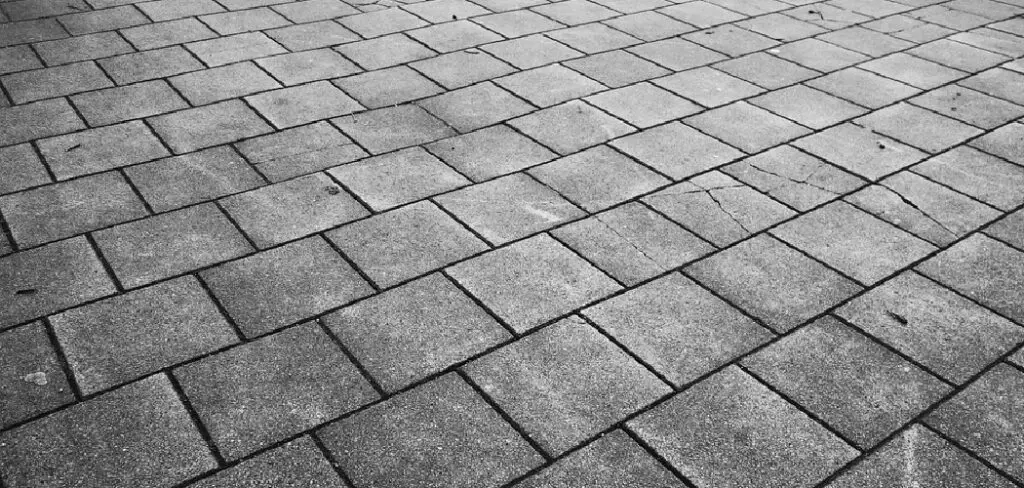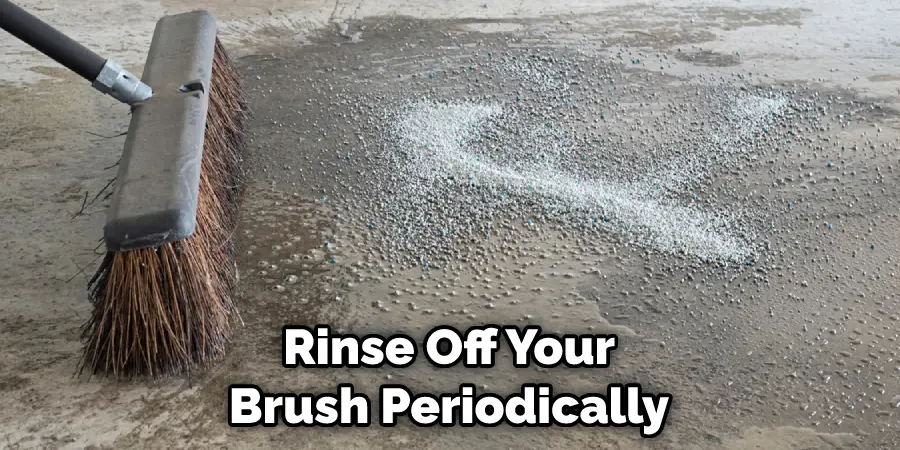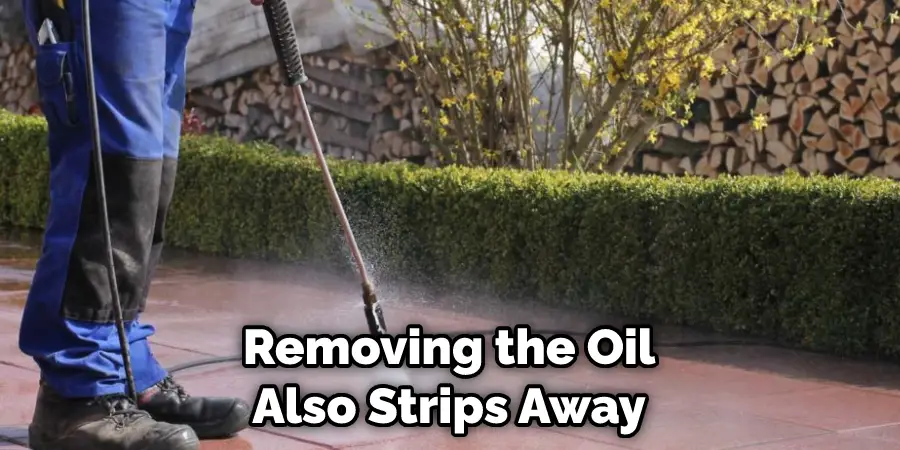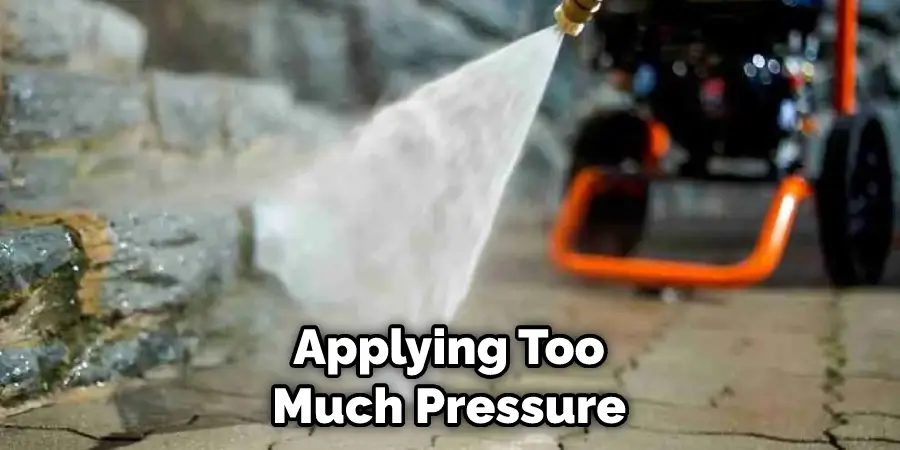Outdoor pavers can add beauty and value to your home but require regular maintenance and cleaning. One of the most challenging things to remove from pavers is oil stains. Whether it’s motor oil, cooking oil, or some other type of oil, it cannot be easy to get rid of.

Luckily, you can take a few simple steps to remove those stubborn oil stains from your pavers. So keep reading to learn more about how to remove oil from pavers.
Can You Remove Oil from the Pavers?
Cleaning oil stains off concrete pavers can be tricky, especially if you don’t plan ahead. To ensure the job is done right, it’s best to first try simple treatments such as a hot water solution and gentle scrubbing before resorting to more caustic options.
This is both cost-effective and less likely to damage the surface. For tougher stains, commercial products or homemade formulas of baking soda and vinegar can help remove oil from pavers when used correctly. However, it’s crucial that you avoid pressure washing your pavers since this can create permanent damage.
With the right approach, it’s possible to effectively clean oil off the pavers – thus ensuring your space remains inviting for visitors.
Why Should You Remove Oil from Pavers?
Removing oil from pavers is a crucial task that should not be taken lightly. Not only does it protect the paver’s color and integrity, but it also helps to keep an area neat and safe.
If left unchecked, oil can become soaked up deep into a paver’s material, becoming extremely difficult to remove without damaging the surface itself. Additionally, without regular maintenance, oil on the pavers can form slippery patches, which have the potential to cause accidents if left unchecked.
Regularly removing oils from pavers allows you to keep your outdoor surfaces looking beautiful while keeping them clean and safe for everyone who visits or uses them.

7 Steps to Follow on How to Remove Oil from Pavers
Step 1: Clean the Area Around the Stain
Before you begin attempting to clean the stain itself, it’s important that you clean any dirt or debris from the area around the stain.
This will make it easier for you to see exactly where the stain is and what kind of shape it’s in. Next, use a broom or brush to sweep away any loose dirt or debris that might be obscuring the stain.
Step 2: Pour Soaking Agent on Stain
The next step is to pour a soaking agent onto the stain. Again, you want something that will help break down the oils without damaging your pavers—white vinegar works well for this purpose.
Simply pour some white vinegar onto the stain and let it sit for about 10 minutes. This will help loosen up any grime or buildup that has accumulated over time.
Step 3: Scrub Away Stain with Brush
Once you have allowed enough time for the vinegar to do its job, grab a stiff-bristled brush and start scrubbing at the stain. Be sure not to use too much force as this could damage your pavers—you just want enough force so that you can work at breaking up any clumps of grime or dirt that may have accumulated around the edges of the stain.
Be sure to rinse off your brush periodically as well so that you don’t spread any dirt back onto other parts of your paver surface.

Step 4: Rinse with Water
After scrubbing away at the stain with your brush, rinse off all residue with a garden hose or power washer (if available). This will help ensure that all traces of vinegar and any remaining dirt are removed from your paver surface before moving on to step 5.
Step 5: Apply Paver Sealer
Next, once all residue has been removed from your paver surface, apply a sealer such as Rain Guard® Paver Shield™ concrete sealer or another product designed specifically for outdoor use on masonry surfaces like yours). Let dry according to package instructions before continuing with any additional projects involving your outdoor space!
Step 6: Apply Paver Stain Remover
Now that the sealer has been applied, it’s time to apply a paver stain remover. This type of product is designed specifically to break down any oils or grease that may have built up over time.
Simply pour some onto the stained area and let it sit for several minutes before wiping it away with a damp cloth or paper towel. Remember to wear gloves and goggles when handling paver stain remover for your own safety!
Step 7: Inspect and Restore
Once the stain remover has been applied, take an extra couple of minutes to do a final inspection of your pavers. If there are still any traces of oil or grease present, you may need to repeat the process.
Once you’re happy with how your pavers look, it’s time to restore them by applying sealer or other products that will help protect and preserve their surface for years to come!
Now that you know how to remove oil from pavers, you can keep your outdoor space looking as good as new all year round! Give these steps a try, and you’ll be able to keep your pavers looking their best.
With regular maintenance, you can rest assured that your outdoor space will remain in tip-top shape for years to come.
Things You Need to Know Before Remove Oil from Pavers
Before removing oil from pavers, it is important to ensure you have the necessary supplies on hand and know the required steps. Begin by making sure you have organic solvent, a putty knife, a cleaning chemical, and rags or sponges available.
Start by using the putty knife to scrape off as much oil as possible. Once all accessible oil is removed, dampen the area with warm water. Next, apply an organic solvent to help release difficult-to-remove oil residue, if applicable.
Finally, use a cleaning chemical designed for pavers before finishing with a rinse of clean water and mopping up excess liquid with rags or sponges. Taking these steps will allow for the successful removal of oil from pavers and restore them back to their original condition.
Benefits of Remove Oil from Pavers
The pavers in your outdoor space can sometimes become contaminated with oil spills. This not only makes them look ugly, but it can also be dangerous if visitors slip or fall. The good news is that removing oil from pavers is relatively easy and can provide a number of benefits outside of just a cosmetic improvement.
Cleaner pavers will last longer, as they won’t be exposed to weathering caused by the pressure and heat associated with the spilled oil. Plus, fewer slick surfaces mean greater safety for you and your guests. Removing the oil also strips away any remaining dirt or modest buildup that may have occurred over time.

While several methods are available for clearing away stubborn stains, a gentle detergent and water are usually enough to restore even the most neglected pavers to their original luster and make them safe to walk on again without worry.
You Can Check It Out to Extend Patio With Pavers
5 Common Mistakes People Make When Trying to Remove Oil from Pavers
1. Not Using the Right Cleaners
One of the most common mistakes people make when trying to remove oil from pavers is not using the right cleaners. There are a variety of cleaners on the market that are specifically designed to remove oil stains, and using the wrong cleaner can actually make the stain worse. So be sure to read the labels carefully and choose a cleaner that is designed for use on pavers.
2. Not Giving the Cleaner Enough Time to Work
Another mistake people make is not giving the cleaner enough time to work. Most cleaners must be left on the stain for at least 10 minutes to be effective, so be sure to follow the instructions on the label.
3. Not Scrubbing Hard Enough
In some cases, simply spraying on a cleaner and letting it sit is not enough to remove an oil stain. You may need to scrub the area with a brush or other abrasive to loosen and remove the oil. Be sure to use a soft-bristled brush to avoid damaging the pavers.
4. Using Too Much Pressure
When scrubbing an oil stain, it is important not to use too much pressure. Applying too much pressure can damage the pavers, so be sure to use gentle strokes when scrubbing.

5. Not Rinsing Properly
After scrubbing an oil stain, it is important to rinse the area thoroughly with water. Any residual cleaner or oil can damage the pavers, so be sure to rinse away all traces of the cleaner before allowing the area to dry.
Conclusion
Oil stains can be an eyesore when left untreated on outdoor pavers, but luckily, they aren’t too difficult to get rid of!
By following these five simple steps—cleaning around the affected area; pouring soaking agent (such as white vinegar) onto the stained area; scrubbing with a brush; rinsing off residue; applying sealer—you should have no problem removing unsightly oil stains from your outdoor pavers in no time.
Armed with this knowledge, now go forth confidently and keep those outdoor spaces looking their best! Thanks for reading our post about how to remove oil from pavers.
You Can Check It Out To Keep Patio Rug in Place

